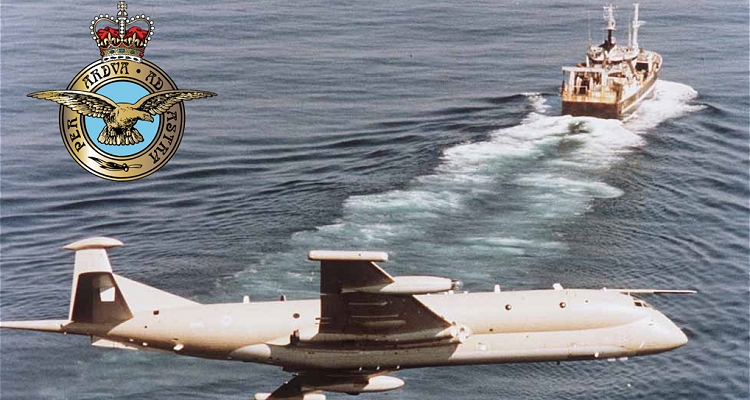Fisheries Protection

Operation Tapestry
The Nimrods were often used to enforce Operation Tapestry. Tapestry is a codeword for the activities by ships and aircraft that protect the United Kingdom's Sovereign Sea Areas, including the protection of fishing rights and oil and gas extraction. Following the establishment of a 200 nautical miles (370 km) Exclusive Economic Zone (EEZ) at the beginning of 1977 the Nimrod fleet was given the task of patrolling the 270,000 square miles (700,000 km2) area. The aircraft would locate, identify, and photograph vessels operating in the EEZ. The whole area was routinely patrolled; in addition to surveillance, the aircraft would communicate with all oil and gas platforms. In 1978, an airborne Nimrod arrested an illegal fishing vessel in the Western Approaches and made the vessel proceed to Milford Haven for further investigation. During the Icelandic Cod Wars of 1972 and 1975–1976, the Nimrod fleet closely cooperated with Royal Navy surface vessels to protect British civilian fishing ships.
MAFF
Dornier Do 228-200 x 2 Fisheries Patrol
BN-2T Turbine Islander x 1 Fisheries Patrol
Direct Flight Sep-98 news Commencement of contract to MAFF Fisheries
DirectFlight May-98 news MAFF announce contract goes to Directflight until 2007
DirectFlight Jun-98 news DirectFlight expand to meet MAFF contract
DirectFlight Dec-98 news Launch of the new MAFF patrol contract with DirectFlight
DAFF
Scottish Fisheries Protection Agency
The Scottish Fisheries Protection Agency is an Agency of the Scottish Executive. It was first established in 1991. The Agency's principal role is the enforcement of fisheries legislation and regulations in the seas around Scotland and in Scottish ports. Two aircraft are operated to patrol the fishing grounds. The aircraft are operated by civilian contractors on 5-year contracts.
The Scottish Fisheries Protection Agency is set to relocate its reconnaissance aircraft from Prestwick to Inverness Airport following a contract award with Highland Airways.
The Agency has signed a five-year deal with the regional air operator to maintain and crew its two Cessna F406 reconnaissance aircraft, which will operate out of Inverness. The contract will commence on 1st April 2004.
The aircraft will be based in Inverness and carry out patrols over Scottish waters. The contract will see Highland Airways employ 12 new members of staff.
The SFPA is responsible for the enforcement of UK, EU and international fisheries law and regulations in the 127,000 square miles of sea around Scotland and, when required, in international waters. This work assists in the conservation of fish stocks and in helping to create the conditions necessary for the existence of a modern and sustainable sea fishing industry.
The Cessna aircraft are part of the SFPA’s inspection assets which include patrol vessels and land-based Fisheries inspectors.
The aircraft operated with the call sign Watchdog 64 and Watchdog 65.
MARINE SCOTLAND
Marine Scotland Compliance owns two Reims Cessna Caravan II F-406 aircraft which are used for aerial surveillance as part of our fisheries enforcement responsibilities. The current aircraft were delivered in 2008 after being built for Marine Scotland Compliance at the Reims factory in France.
The aircraft are currently based at Inverness Airport and responsibility for providing aircrew and maintenance is contracted out to Airtask.
The aircraft are tasked daily by the Fisheries Monitoring Centre, taking account of enforcement priorities identified following an analysis of available information resources.
One of the aircraft is fitted with a visible light and infra-red video camera. This camera also has a laser illuminator which aids vessel identification in low and no light conditions.
The aircraft operate with the callsign Watchdog Alpha and Watchdog Bravo.
DEFRA
The Marine Management Organisation (MMO) was created in 2009 by the Marine and Coastal Access Act.
MMO is an executive non-departmental public body, sponsored by the Department for Environment, Food & Rural Affairs.
The aircraft operated with the call sign Watchdog 71 & Watchdog 72.
References:
Parliamentry debate: Monday 2nd May 1977
Web site: Caithness.org
